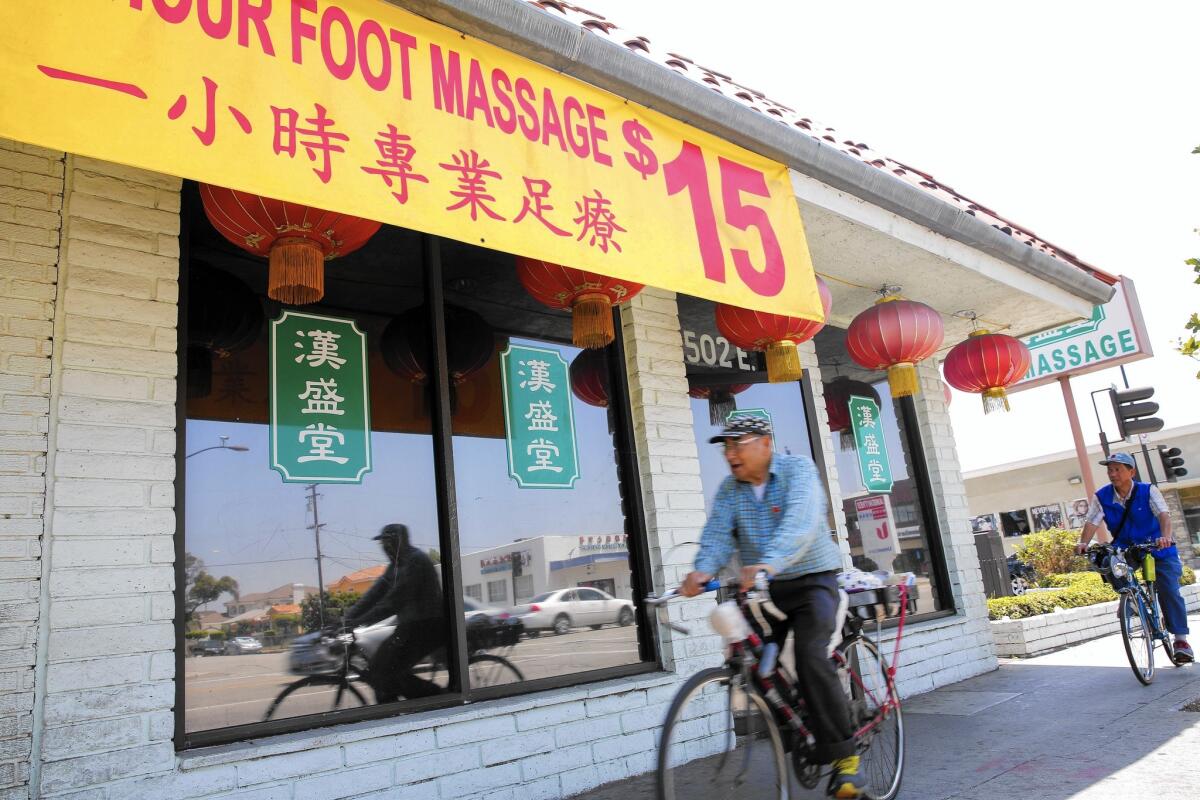Officials struggle to regulate legitimate and unsavory massage parlors

Massage parlors have flourished in the San Gabriel Valley. California cities are weighing how to regulate such businesses.
By day, a crew of masseurs at one of the San Gabriel Valley’s many foot massage businesses offer to sooth the aches and pains of a mostly elderly and female clientele.
When the sun sets, glowing red paper lanterns click on at another part of the establishment, where a younger female massage staff caters to mostly male customers.
The question of what’s going on in such establishments, and what, if anything, local authorities can or should do about it, has taken on new focus as California cities decide how to use new regulatory tools given to them by an amendment to the state’s massage law that went into effect this year.
The move follows a 2011 amendment that — following lobbying by the massage industry — loosened restrictions and unleashed a proliferation of new businesses statewide.
The number of state-certified masseuses has risen 13% since 2014 to 51,885 this year, according to the California Massage Therapy Council, a nonprofit that the state created in 2009 to certify masseuses, approve schools and standardize curriculum.
Nationwide, the massage industry is growing as medical establishments increasingly embrace massage’s therapeutic benefits, according to the Bureau of Labor Statistics, which estimates the number of massage therapist jobs will grow 23% between 2012 and 2022.
Relatively cheap and easy to get off the ground, massage businesses have been spreading most notably in places with large numbers of immigrants from China, where massages are as common as haircuts and the practice has a long history.
Massage businesses have flourished, for example, in the predominantly Asian San Gabriel Valley. Since California relaxed its law in 2011, a dozen new massage parlors opened up in Arcadia. South Pasadena, a 3.4-square-mile community of 25,000, now has 19. Monterey Park gained at least half a dozen, and surrounding cities have experienced similar increases.
According to the council, more than 5,400 massage technicians list home addresses in Monterey Park, San Gabriel, Rosemead or Alhambra — 10% of the massage technicians in the entire state.
Now that cities have more authority over massage parlors, officials are weighing how to balance the rights of a growing profession of legitimate massage therapists against the responsibility to solve problems caused by the less savory businesses.
An athlete with sore muscles or an office worker with a stiff neck could not browse long online without running into websites offering Yelp-style reviews of sexually oriented massage parlors. Posters swap information, using abbreviations and acronyms to throw authorities off the trail. One site shows 44 erotic massage establishments in San Gabriel alone.
Ahmos Netanel, chief executive of the nonprofit council, said that the vast majority of masseuses provide legitimate services to a clientele that is largely female.
Netanel said his organization supports any effort to rein in prostitution. But he argues that it would be unfair for authorities to regulate any industry based on a distorted negative stereotype. It doesn’t help, he says, that California law has flip-flopped between accepting massage as legitimate therapy and demonizing it over the sins of a few.
“You can’t prevent prostitution with a conditional use permit or zone for it,” Netanel said. “You can’t regulate for a criminal enterprise.”
Lt. Brian Kott has headed the team that enforces massage regulations in the San Gabriel Police Department for two years. The number of massage businesses in the city has more than doubled to 59 in an area of about four square miles — so many new massage parlors that the city recently hired an additional code enforcement officer to keep pace with inspections.
“A lot of these are hardworking people,” Kott acknowledges. “But prostitution does go on.”
He said his department has made 25 prostitution-related arrests in the city since 2013, eight of them at massage businesses. They conducted 13 sting operations last year, and two massage businesses were closed as a result.
Targeting prostitution is particularly tricky, says Clayton Anderson, San Gabriel’s neighborhood improvement services manager. Many Chinese massage businesses, he says, operate like loose collectives. Property owners charge fees to masseuses but rarely show up to manage the business themselves. Masseuses hop between businesses depending on where the foot traffic is best — so they’re often able to stay a step ahead of the police, he says.
A study by the Urban Institute, a think tank, described a highly organized sex trafficking ring revolving around a chain of massage parlors in New York City, Seattle, San Francisco and Los Angeles.
In January, the San Gabriel Valley city of Montebello closed U-Spa, a massage business, after police made a prostitution arrest there. Local authorities never charged its owner, Estella Xu, with any crime, but she and two relatives are facing prostitution and human trafficking charges in Delaware.
Among the people most upset with the San Gabriel Valley’s influx of massage establishment are the practitioners, who complain that the glut has driven their hourly rates below $20 an hour.
“This is the cheapest place to get a massage in America,” says Xiao Chen, a masseuse at the Shangri-La Day Spa on Valley Boulevard.
Chen became a masseuse seven years ago to make money. She paid about $3,800 for courses at a Chinese-run school of massage, then a few years ago, changes in state law made her certification invalid, she says. She invested two months and an additional $3,800 on courses at a council-approved school.
Yet she says she takes home as little as $10 a day.
“We can’t make any money, and we have to pay our boss,” Chen says, raising her arms to display elbows rubbed black and shiny by countless massages. “Hun ku,” she said, using a Chinese phrase that means bitter, miserable and painful.
Masseuses argue that the new laws are too restrictive.
San Gabriel’s 26-page massage ordinance specifies, for example, what parts of the body clothes must cover, the width of the padding on the tables and chairs and how bright a room should be down to the lumen, a light measurement unit. The city conducts quarterly checks for compliance.
Meng Shi, a masseuse at Enjoy Spa, says the regulations are choking the life from her business. She points to the sun streaming in through the open front door — the business was fined $100 for closing the curtains that kept out the light. The business was fined an additional $100 because their massage certificates were leaning against the wall instead of hanging on the wall. Name tags not displayed properly, customers using the back entrance — more fines.
“It feels like they are targeting us,” Shi says. “We got the certificate, we went to the schools and got all the certifications. But we can’t work unless we are treated fairly.”
Shi’s business is at the intersection of San Gabriel Boulevard and Broadway Avenue, where at least six massage establishments — three of them with “Grand Opening” signs — cluster around a tea shop, an army recruitment center, two restaurants and an Edible Arrangements store.
Manny Serrano, the owner of the Edible Arrangements store, says he doesn’t doubt that some massage businesses are legitimate. But at the massage parlor next door, he said he had seen the women touch their genitals to solicit bystanders, he says.
“I understand there are therapeutic reasons for massage, but when you have eight or 10 on the same block, you have to think there’s something going on,” Serrano said. “My customers always comment on it.”
Down the street, David Huynh just opened a new window- and door-installation business. There’s a massage parlor on both sides. Huynh says he thinks his neighbors will help bring him walk-in traffic.
“Homeowners like massages too,” Huynh says.
More to Read
Start your day right
Sign up for Essential California for news, features and recommendations from the L.A. Times and beyond in your inbox six days a week.
You may occasionally receive promotional content from the Los Angeles Times.







